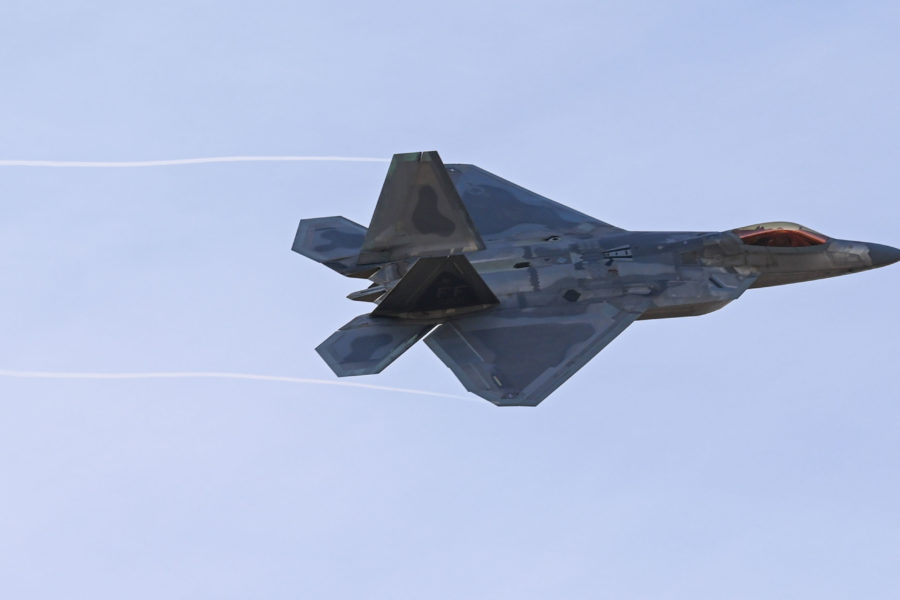The U.S. Air Force successfully shot down a Chinese spy balloon off the coast of South Carolina on Feb. 4, ending days of uproar, speculation, and confusion. At 2:39 pm Eastern time, an F-22 Raptor from the 1st Fighter Wing at Joint Base Langley-Eustis, Va. fired one AIM-9X Sidewinder into the approximately 90-foot wide balloon, causing it to fall towards the Atlantic Ocean, according to senior U.S. defense and military officials.
“We successfully took it down, and I want to compliment our aviators who did it,” President Joe Biden said.
F-15s from Barnes Air National Guard Base, Mass., well as well as multiple tankers assisted in the effort, according to the Pentagon. In a briefing to reporters, U.S. defense and military officials said an F-22 fired the Sidewinder from 58,000 feet, hitting the balloon operating at around 60,000 to 65,000 feet. It is the first known air-to-air takedown for an F-22. The shootdown came after the U.S. ordered a ground stop at nearby airports and closed airspace in the vicinity.
“At the direction of President Biden, U.S. fighter aircraft assigned to U.S. Northern Command successfully brought down the high altitude surveillance balloon launched by and belonging to the People’s Republic of China (PRC) over the water off the coast of South Carolina in U.S. airspace,” Secretary of Defense Lloyd J. Austin III said in a statement. “The balloon, which was being used by the PRC in an attempt to surveil strategic sites in the continental United States, was brought down above U.S. territorial waters.”
For days, the Department of Defense sought to explain how a surveillance asset from its main rival had managed to end up—and stay—in American airspace, even as the U.S. acknowledged it was tracking the balloon that was trying to take a peek at sensitive national security sites.
The balloon first entered the U.S.’s air defense identification zone (ADIZ) near Alaska on Jan. 28, north of the Aleutian Islands and moved largely across land, a senior defense official said. North American Aerospace Command (NORAD) has previously escorted warplanes planes out of the U.S.’s ADIZ, which serves as a protective buffer beyond U.S. airspace. But the balloon continued to fly even as the U.S. tracked it, the official said, and entered Canadian airspace on Jan. 30., which is protected jointly by the U.S. and Canada through NORAD, before reentering U.S. airspace in northern Idaho Jan. 31.
F-22s from Nellis Air Force Base, Nev. were scrambled on Feb. 1, when the senior defense official said the U.S. considered shooting down the balloon over Montana—where Malmstrom Air Force Base, one of U.S.’s nuclear international continental ballistic missile (ICBM) sites, is located.
“After careful analysis, U.S. military commanders had determined downing the balloon while over land posed an undue risk to people across a wide area, due to the size and altitude of the balloon and its surveillance payload,” Austin said.
The Pentagon’s failure to acknowledge the incident until Feb. 2—after it had been spotted by civilians over Montana—prompted consternation on both sides of the aisle in Congress. The incident led to the cancellation of Secretary of State Antony Blinken’s scheduled visit to China, which was supposed to occur Feb. 3. It would have been the first cabinet-level visit by a U.S. official to occur during the Biden administration.
China claimed the balloon was a weather balloon that had drifted off course.
“China regrets that the airship strayed into the United States due to force majeure,” China’s foreign ministry said in a statement Feb. 3., referring to a situation out of its control.
U.S. officials did not buy that assertion, saying it was clearly a spy asset, and Austin said in his statement the balloon’s flight was an “unacceptable violation of our sovereignty.”
It is also apparently not the first incident of its type. Pentagon officials said Chinese surveillance balloons have entered U.S. airspace since the Trump administration, though the U.S. has not previously acknowledged the incidents. And America has not been the only nation targeted.
“Over the past several years, Chinese balloons have previously been spotted over countries across five continents, including in East Asia, South Asia and Europe,” a senior defense official said. The Pentagon said another Chinese balloon is currently flying over Latin America.
Members of the president’s own party have called for further explanation from the administration and the Pentagon, even as they praised the way Biden handled the situation. Many Republicans blasted the administration for not shooting down the balloon earlier. After the downing, Biden said that he had ordered the balloon shot down “as soon as possible” on Feb. 1, but it was unsafe to do so at that time.
“President Biden made the right decision to shoot down this alleged Chinese spy balloon out of range of American civilians and infrastructure,” Sen. Jack Reed (D-R.I.), chairman of the Senate Armed Services Committee said in a statement Feb. 4. “I look forward to a full briefing on the situation and U.S. plans moving ahead.”
As the balloon finally drifted over the Atlantic, two Langley F-22s, using the callsigns FRANK01 and FRANK02, finally brought the balloon down. A NORTHCOM spokesperson said the callsigns were a homage to Lt. Frank Luke Jr., a World War 1 ace and Medal of Honor recipient. Luke was nicknamed the “Arizona Balloon Buster” after destroying 14 German balloons in 17 days. Luke Air Force Base, Ariz. is named in his honor.
The Navy and Coast Guard are searching for the balloon debris in 47 feet of water six miles off the coast of South Carolina, according to the DOD, though debris could be spread for miles.
“I ordered the Pentagon to shoot it down,” Biden said. “The best time to do that was when it got over water.”

